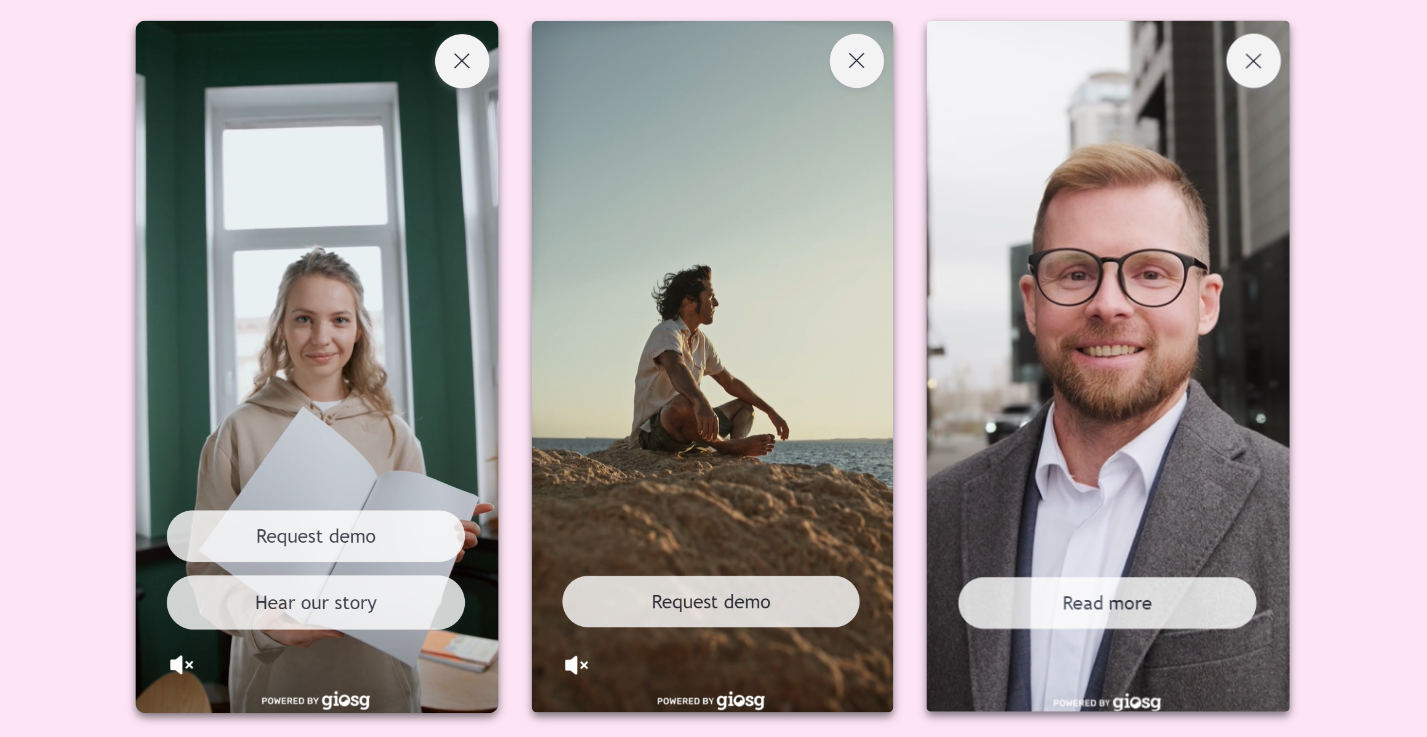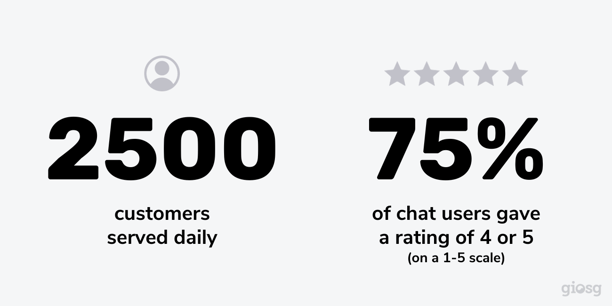44% of consumers say that nothing excuses a poor customer experience.
Not even if it’s a brand they like.
In this article, we go over the best practices for optimizing your digital customer experience strategy.
And to look into what this looks like in real life, we also share 3 examples from some of the leading companies.
🎙️ If you're not much of a reader, feel free to check out the giosg Digital Customer Experience Podcast instead!
Table of contents
What is digital customer experience?
Optimizing the digital customer journey – Best practices
Top 3 digital CX examples by industry
Key takeaways
What is digital customer experience?
Think of digital customer experience (DCX) as every way your customers interact with your brand online – from browsing your website or using your mobile app to engaging on social media.

Just like traditional customer experience, DCX covers everything from their first click to making a purchase and getting support after.
But what makes a successful digital customer experience strategy?
Here are some key elements to think about:
- Seamless navigation
- Personalized content
- Responsive customer support
- Intuitive design
By blending these elements across digital touchpoints, you're rolling out the red carpet for your customers – making them feel valued and understood.
Why is digital customer experience important?
Almost 50% of consumers prefer shopping from companies that do personalization and customer experience well.
👉 30% of people can even let a bad experience slide if they see that the company is pushing an effort to get them.
A good digital customer experience management simply helps you build loyal, engaged and satisfied customers.

It's essentially the tool that helps you stand out from your competitors and keep customers coming back to you.
Just think about your own experiences of handling things or shopping online.
We've all experienced the good and the bad when it comes to CX. For example, when browsing on Amazon or handling issues with your bank.
Now that we've grasped what digital customer experience is, let's look at the different ways to optimize digital CX strategy from initial awareness to post-purchase engagement.
How to improve your digital customer experience – 4 Best Practices
In an episode of the Digital Customer Experience podcast, Helge Tennø, the Director of Customer Experience and Delivery at MSD, summarized his experience by saying:

To help you with this, here's a straightforward breakdown of the role of CX in the digital customer journey:
1. Use storytelling and targeted messages
In the initial stages, the key is to offer captivating content that resonates with the audience.
This can mean targeting specific articles or distributing video greetings that can help grab the attention of potential customers.
Or even incorporating podcasts into your content strategy. This can also be a compelling way to engage your audience and deliver valuable insights.
Targeted elements across your digital channels increase visibility and brand recognition.
On your website, this can mean pop-ups or even a chat or video bot that greets your customers with the most relevant information for them.

Especially in industries like telecom where the customers' investments can be expensive, being there to address their concerns from the start is so important.
In an episode with Paul Prior from Three Ireland, Paul highlights:

2. Provide information and tools for decision-making
As customers move into the consideration phase, they want to see detailed information about your products or services.
.png?width=1300&height=650&name=blog%20preview%20image%20(32).png)
Do ✅ offer comprehensive product descriptions, comparison tools, calculators, and customer reviews. These can be very effective in helping them in their decision-making process.
Also, interactive tools like product recommendations, quizzes or live chat support can be great tools for addressing customer queries quickly (addressing any possible hesitation) and creating a sense of trust and confidence in potential buyers.
3. Streamline the buying process
Simplicity is key when your visitors are thinking about making a purchase.
Designing an intuitive and user-friendly interface ensures the visitor experiences easy navigation through the purchase funnel.
At this point, you need to pay attention to clear product information and hassle-free checkout processes.
Also, emphasizing security measures and offering multiple payment options can do wonders for building the customer’s confidence and minimizing cart abandonment rates.
4. Build long-term relationships
To retain customers and encourage repeat purchases, make sure to focus your efforts on things like:
- proactive customer support
- loyalty programs
- creating upselling opportunities
- and personalized follow-ups
Any one of these should also include asking for customer feedback.
Using customer data together with your visitor analytics will give you all the information you need to improve their experiences accordingly and increase customer lifetime value.

Using personalization beyond just the purchase strengthens your bond with existing customers and ensures ongoing overall customer satisfaction.
By tailoring strategies specific to each stage of the digital customer experience journey, you build a seamless experience for your visitors across digital platforms.
Now that we've explored the strategies and stages that shape a remarkable digital customer journey, let's dive into real-world examples of businesses that have successfully implemented seamless customer interactions.
Top 3 digital CX strategy examples by industry
To get you inspired and another step closer to building your world-class digital experience, let’s look at some of the great examples from online experience leaders across industries:
1. Omnichannel customer engagement in telecom
Products in the telecom industry can often be expensive and complex – which is why the buyer might need extra help before purchasing.
Telia took a significant step towards solving this by providing seamless in-store experiences online that exceed the high quality of the support in their physical stores.
This helped them build an omnichannel experience for their customers.

Telia decided to include a live one-to-one video option on their website, in which the online customer can get the guidance and support they need on a video call with a Telia sales agent.
This way Telia can capture customers and guide them correctly when it comes to some of the complex, expensive items.
As a result, their store performance has reached a 30% conversion rate 🔥
2. Live support and product recommendations in eCommerce
Customer experience looks a bit different in each industry since customer needs often vary.
When compared to the telecom example, companies working around healthcare face many challenges and high demands with legal requirements and security aspects.
It can be a challenge for internal teams, like customer service, to innovate and find the right tools that meet their high requirements.
Apotek Hjärtat, the market-leading pharmacy chain with 400 physical pharmacies and a strong focus on its digital presence, sets a great example of tackling these challenges while taking their pharmacy’s customer experience to the next level.

Their team has implemented live chat and product guides on their website to offer smooth experiences for each of their website visitors – without leaving anyone unattended.
Simple efforts bring great results
Apotek Hjärtat now serves around 2500 customers daily and thanks to the speed at which they can cater to each of them, they have exceeded their customer expectations.
75 % of their chat users rate their experience 4 or 5 out of 5 rating 🌟
Next, they’re even looking into using artificial intelligence (AI) as a part of their long-term CX strategy.
Feeling inspired yet?
3. Gamification and interactive elements to engage throughout the customer journey
Our next example shows more creative ways to engage your customers (beyond just enhanced customer support) through marketing.
Finland’s leading bookstore has explored many different types of interactive content to drive online traffic and increase engagement with its potential and existing customers.
This has been key for them to stay ahead of the competition!
.png?width=612&height=344&name=Blog%20visuals%20(65).png)
Suomalainen Kirjakauppa delighted their easter time website visitors with this cool "Egg Hunt" idea where visitors could find hidden discount codes by clicking on Easter eggs. And for Mother's Day, they used a fun product recommendation quiz to help customers find perfect personalized gifts.
Suomalainen Kirjakauppa also got into promoting sustainability with a quiz about responsible practices. This got them over 600 new newsletter subscribers and helped grow their community.
Key takeaways
1. Emphasis on customer-centricity
The year 2024 is marked by a clear focus on customer-centric experience design as a driving force for brands. With 44% of consumers unwilling to excuse poor CX, companies must prioritize enhancing digital interactions to maintain a competitive edge.
Companies also need to understand the digital customer journey and preferences better since that's the only way to cater to the right audience.
2. Learning from industry leaders
Insights and examples from CX professionals offer valuable insights and give inspiration in the right direction.
Or simply look at the brands that you and the people around you know and love – that's an easy way to see what works!
3. Continuous improvement and adaptation
Constant innovation is key when it comes to digitalization.
As we step into 2024, creating engaging and simply functional online interactions between customers and brands is a non-negotiable for businesses.
And as new trends come and go, you need to adapt and evolve your CX strategies to meet changing demand.
Are you feeling inspired? Let us know what you're looking for and we're happy to discuss this with you further and help you build your dream customer experience 😊
If you want to keep on learning head over to check out the results of our customer experience research!👇
